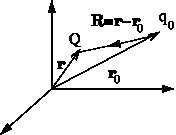Coulomb’s law is stated for electric field of a point particle. For several point charges the field is obtained as a vector sum of the fields of individual charges
Force due to a system of point charges
Consider a system of two charges, \(Q\) at a position $\vec{r}$ and \(q\) at position $\vec{r}_0$.
Let \(F\) is the force on the charge \(q\) due to charge \(Q\) and \(\vec{F}^\prime\) be the force on the charge \(Q\) due to the charge \(q\). Then the magnitudes of \(\vec F\) and \(\vec F^\prime\) are equal in magnitude
\begin{equation}\label{EQ02}
|\vec F| = |\vec F^\prime| =\frac{1}{4\pi\epsilon_0}\frac{qQ}{R^2}, \qquad \vec R = \vec r-\vec r_0
\end{equation}
and obey the inverse square law,
where \(R\) is the distance between the charges. 
The forces \(\vec F, \vec F\prime\) act along the line joining the two charges and is equal and opposite in the sense of Newton's third law.\\
The force \(\vec{F}, \vec F^\prime\) on the charge \(Q\) due to the charge \(q\) can be written as a vector equation
\begin{equation}\label{EQ01}
\vec{F} =\frac{qQ}{4\pi\epsilon_0}\frac{(\vec{r}-\vec{r}_0)}{|\vec{r}-\vec{r}_0|^3}
\end{equation}
Here \(\vec r, \vec r_0\) are the positions of charges \(Q,q\) respectively.
The force on a given point charge \(Q\) located at $\vec{r}$ due to several point
charges $q_1,q_2,\ldots, q_N$ is given by the vector sum of the force on \(Q\) due to each
of the charges $q_1,q_2,\ldots, q_N.$
If position of $ q_1$ is $\vec{r_1}$, $q_2$ is $\vec{r_2} , \ldots $, then
\begin{eqnarray}\label{EQ04}
\vec{F}=\sum_k\Big(\frac{q_k\,Q}{4\pi\epsilon_0}\Big)\frac{(\vec{r}-\vec{r}_k)}{ \mid\vec{r}-\vec{r}_k\mid^3}.
\end{eqnarray}
We say that the force due to system of point charges is obtained by {\it superposition of forces} due to the individual charges.
Electric field and the superposition principle
Faraday introduced the concept of electric field. A charge produces {\tt electric field} in the space around it. When there is another charge located at some point \(P\), the field exerts a force on the point charge. The field exists even if no other
charge is present.
The Coulomb force between charges acts instantaneously. If one of the charges is moved a little, change in its force should be felt
immediately
on other charges present even if they are very far off say millions of light years away.
This is inconsistent with special theory of relativity which says that no signal can travel faster than light.
The concept of electric field
bypasses this problem.
The electric field due to system of charges is defined as the force on unit positive charge.
Thus the electric field at a point \(\vec{r}\) due to a point charge \(q_0\) located at \(\vec{r}_0\) is
\begin{equation}\label{EQ03}
\vec{E} =\frac{q_0}{4\pi\epsilon_0}\frac{(\vec{r}-\vec{r}_0)}{|\vec{r}-\vec{r}_0|^3}
\end{equation} Let $q_1,q_2,q_3,\ldots, q_N$ be a system of \(N\) charges located at positions $\vec{r}_1,\vec{r}_2,\ldots,\vec{r}_N$. Thus the electric field due to these charges at point $\vec{r}$, being the force on {\it unit positive charge} is given by setting \(Q=1\) in \Eqref{EQ04}. Therefore the field due to the system of \(N\) charges is
\begin{eqnarray}\label{EQ05}
\vec{E}=\sum_k\left(\frac{q_k}{4\pi\epsilon_0}\right)
\frac{(\vec{r}-\vec{r_k})}{\mid\vec{r}-\vec{r}_k\mid^3}.
\end{eqnarray}
The above equation is just the statement of the superposition principle for the electric field.
Superposition principleFor a system of several charges $q_k$, the electric field at a pointis equal to the sum of electric fields due to the individual charges. |
The field of a point charge at large distance,\eqref{EQ03}, is given by
\begin{equation}
\vec{E} \approx \frac{q_0}{4\pi\epsilon_0}\frac{(\vec{r}-\vec{r}_0)}{|\vec{r}-\vec r_0|^3}.
\end{equation} For a system of localized charges, each term in the summation in \eqref{EQ05}, behave in the same manner and for large \(r\) we get
\begin{eqnarray}\label{EQ06}
\vec{E}\approx \sum_k\left(\frac{q_k}{4\pi\epsilon_0}\right)\frac{(\vec{r}-\vec{r_k})}{\mid\vec{r}\mid^3}
= \frac{Q}{4\pi\epsilon_0}\frac{\vec r}{|\vec r|^3}.
\end{eqnarray} where \(Q=\sum_k q_k\) is the total charge.
This is intuitively obvious that the system looks as if all charges are concentrated at the origin.
Thus the field at large distances approximates the field of a point charge \(Q\).
Rreferences
``What are Fields?'' Sec 1-5
R. P. Feynman, Robert B. Leighton and Mathew Sands{\it Lectures on Physics}, vol-II, B.I. Publications (1964)
Exclude node summary :
Exclude node links:
4727:Diamond Point






 ||Message]
||Message]
